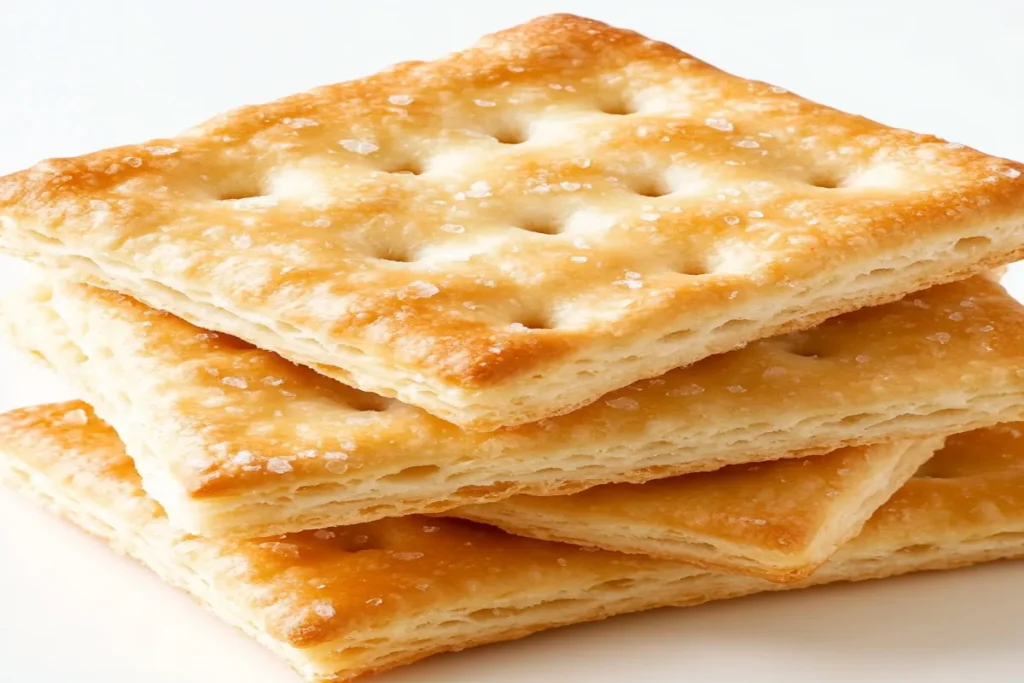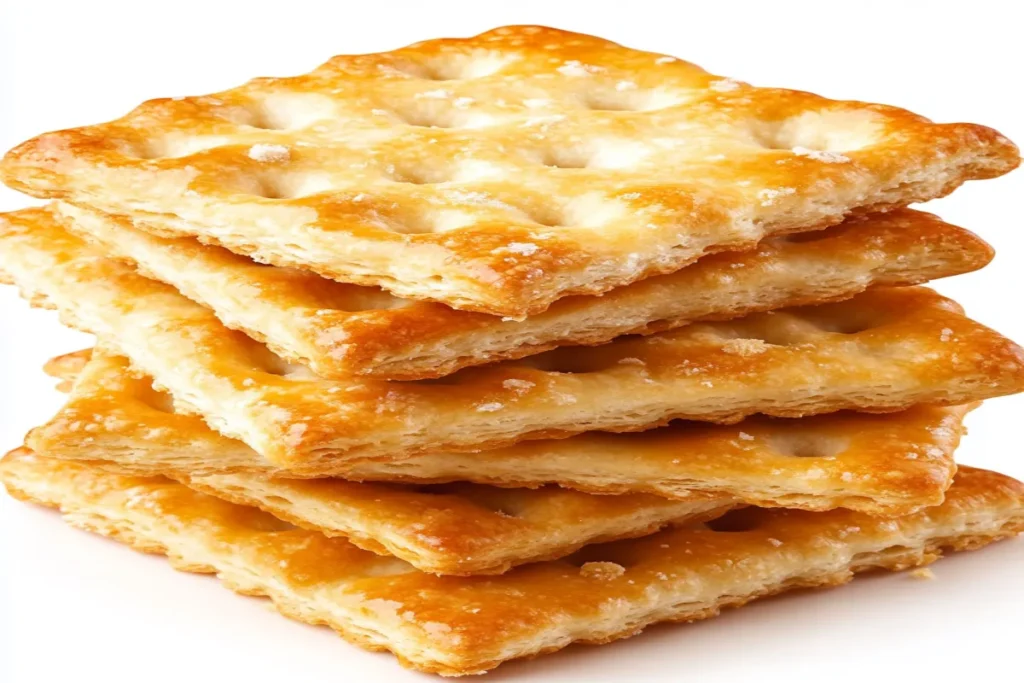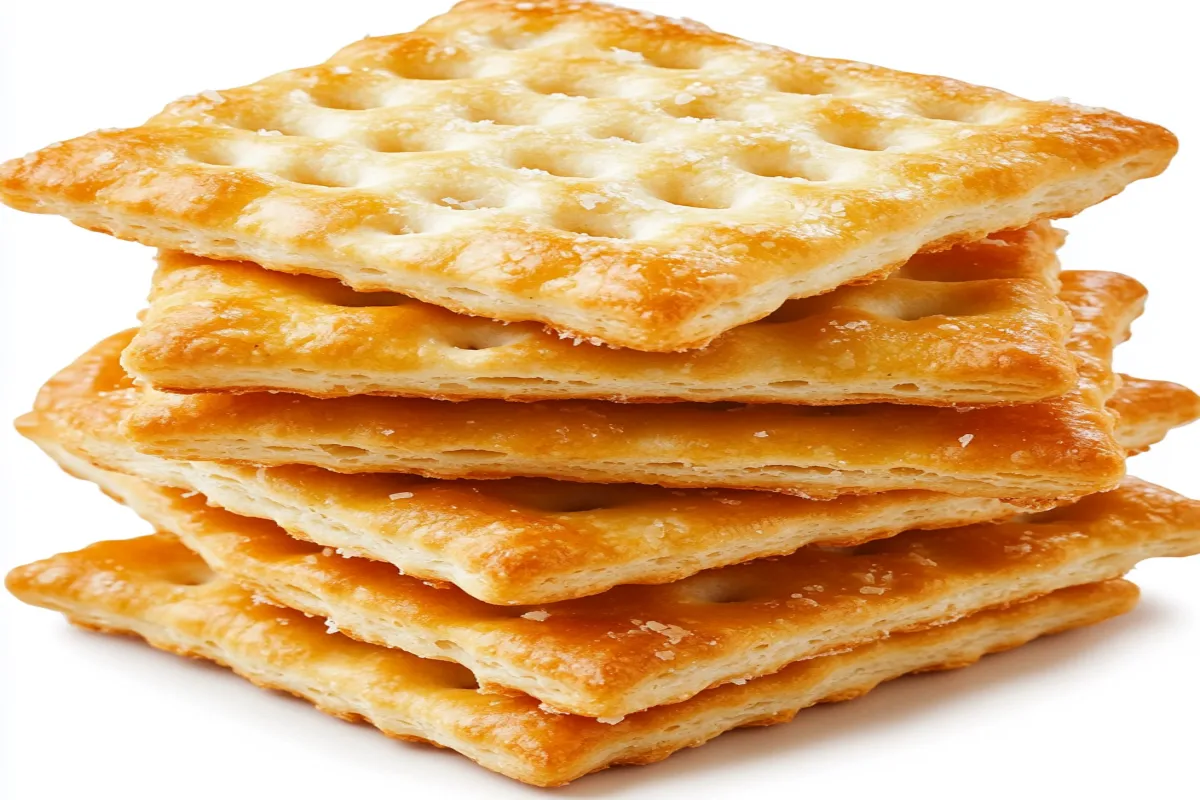Saltine crackers have long been a pantry essential, prized for their light, crisp texture and subtle flavor. Whether enjoyed on their own or paired with soups, salads, or cheeses, these versatile crackers offer a satisfying crunch. More than just a snack, saltines hold a special place in culinary traditions and everyday meals.
The History of Saltine Crackers
The origins of saltine crackers trace back to the early 19th century when they were first known as soda crackers, named for the baking soda used in their preparation. By the late 19th century, the addition of a light salt topping led to the name “saltine,” distinguishing them as the savory, flaky crackers we recognize today. Over time, they became a beloved household staple, adding texture and flavor to a variety of dishes.
- Origin and Invention: Saltine crackers were invented by a baker named Josiah Bent in 1801 in Newburyport, Massachusetts. Bent’s crackly biscuits gained popularity, and by the late 1800s, they were being mass-produced.
- Evolution Over the Years: The production of this snack saw significant advancements with the advent of modern baking techniques. The iconic perforations, or “docking holes,” in the crackers were introduced to prevent puffing during baking, ensuring a flat and crispy texture.
- Key Milestones: A significant milestone in the history of this snack was the introduction of the first branded saltine by Nabisco in 1876. This move transformed them from a local bakery item to a household name across America.
Through the years, this snack have maintained their popularity, evolving in packaging and marketing but staying true to their original, beloved form.
By understanding the roots and journey of this snack, we appreciate their simple elegance even more. As we move forward, we’ll explore the ingredients, varieties, and more, unraveling what makes these crackers so special.
Composition and Varieties
Ingredients and Nutritional Information
this snack may seem simple, but their ingredients and nutritional content reveal much about their appeal and versatility.
- Basic Ingredients: Traditional saltine crackers are made from flour, baking soda, yeast, and a touch of salt. These basic components give them their distinctive, mild flavor and crisp texture.
- Nutritional Profile: A typical serving of this snack (about 5 crackers) contains:
- Calories: 60-70
- Total Fat: 1-1.5g
- Cholesterol: 0mg
- Sodium: 120-180mg
- Total Carbohydrates: 12-14g
- Protein: 1-2g
These crackers are low in fat and calories, making them a light snack option. However, the sodium content can be a consideration for those monitoring their salt intake.
Varieties of Saltine Crackers
Over the years, saltine crackers have diversified, offering consumers various options to suit different tastes and dietary needs.
- Different Brands and Their Special Features:
- Nabisco Premium Saltines: Known for their consistent quality and classic taste, they are a go-to choice for many.
- Lance Saltines: These offer a slightly different texture and flavor, often preferred for their robustness.
- Comparison of Regular vs. Unsalted Tops: Regular saltine crackers come with a light sprinkling of salt on top, enhancing their flavor. Unsalted tops, however, cater to those seeking a lower sodium option without compromising the cracker’s crunch.
- Mini Saltine Crackers: These bite-sized versions are perfect for snacking or adding to soups and salads without the need to break them up. Their small size makes them convenient and versatile.
Uses and Recipes
Common Uses of Saltine Crackers
Saltine crackers are more than just a snack; they’re a versatile ingredient in many dishes. Their mild flavor and crunchy texture make them a perfect companion to various foods.
- Snacks: Saltine crackers are often enjoyed straight out of the box. Their simplicity makes them a great snack on their own or with a spread like peanut butter or cheese.
- Pairing with Soups and Salads: One of the most popular uses for saltine crackers is as a side with soups and salads. They add a satisfying crunch and help soak up broth, enhancing the overall dining experience.
Popular Recipes Involving Saltine Crackers
The humble saltine cracker can be transformed into delightful dishes with a bit of creativity. Here are some popular recipes that showcase their versatility:
- Saltine Toffee: Also known as “Christmas Crack,” this treat combines the saltiness of crackers with sweet toffee and chocolate. It’s an easy-to-make dessert that’s loved by many.
- Ingredients: this snack, butter, brown sugar, chocolate chips, and optional toppings like nuts or sprinkles.
- Instructions: Line a baking sheet with saltine crackers. Melt butter and brown sugar together and pour over the crackers. Bake until bubbly, then spread chocolate chips over the top. Let it melt, then spread evenly. Chill until set and break into pieces.
- Homemade Saltine Cracker Recipe: Making your own saltines is a rewarding process that results in a fresher, more flavorful cracker.
- Ingredients: Flour, baking soda, butter, water, and salt.
- Instructions: Mix flour and baking soda, then cut in butter until the mixture resembles coarse crumbs. Add water and form a dough. Roll out thin, cut into squares, dock with a fork, and sprinkle with salt. Bake until crisp.
- Saltine Cracker Pie Crust: This unconventional pie crust adds a unique twist to both sweet and savory pies.
- Ingredients: Crushed saltine crackers, sugar (for sweet pies), or herbs (for savory pies), melted butter.
- Instructions: Mix crushed crackers with sugar or herbs and melted butter. Press into a pie dish and bake briefly to set.
Health Considerations
Health Benefits and Concerns
this snack can be a convenient and tasty addition to your diet, but it’s essential to understand both their benefits and potential health concerns.
- Benefits of Moderate Consumption:
- Low Calorie Snack: this snack are relatively low in calories, making them a good choice for those watching their weight.
- Digestive Aid: The blandness of this snack can help soothe an upset stomach, often recommended for people experiencing nausea or digestive issues.
- Convenience: They’re easy to store and carry, making them a quick and convenient snack option.
- Potential Health Risks:
- High Sodium Content: One of the primary concerns with saltine crackers is their sodium content. High sodium intake can lead to increased blood pressure and other health issues. It’s crucial to monitor how many crackers you consume, especially if you are on a low-sodium diet.
- Low Nutritional Value: While they provide quick energy, saltine crackers don’t offer much in the way of essential nutrients like vitamins and minerals. Relying on them too heavily can lead to a lack of nutritional variety in your diet.
Dietary Considerations
Given their simple ingredients, this snack can fit into various dietary preferences and restrictions.
- Gluten-Free Options: Traditional saltine crackers contain wheat flour, which means they are not suitable for those with gluten intolerance or celiac disease. However, there are gluten-free versions available on the market made with alternative flours such as rice or almond flour.
- Vegan and Organic Varieties: Many saltine crackers are vegan by default since they do not contain animal products. For those looking for organic options, several brands offer crackers made with organic ingredients, ensuring no synthetic pesticides or fertilizers were used.
this snack can be a part of a balanced diet if consumed mindfully. By understanding their nutritional content and being aware of potential health risks, you can enjoy them without compromising your health.

Market and Brands
Leading Brands and Their Offerings
The market for saltine crackers is diverse, with several leading brands offering their unique take on this classic snack. Each brand has its special features, catering to different tastes and preferences.
- Nabisco Premium Saltines: Perhaps the most well-known brand, Nabisco’s Premium Saltines have been a household staple for decades. They are praised for their consistent quality and classic taste. Available in various packaging options, including individual snack packs and family-sized boxes, they’re perfect for any occasion.
- Lance Saltines: Lance offers a robust alternative to the traditional saltine. Known for their slightly thicker and more flavorful crackers, Lance saltines are often preferred by those who enjoy a bit more substance in their snacks.
- Other Notable Brands:
- Great Value Saltine Crackers: A budget-friendly option available at Walmart, these crackers provide good quality at a lower price point.
- Zesta Saltine Crackers: Another popular choice, Zesta crackers are known for their crisp texture and satisfying crunch.
Market Trends
Understanding the market trends for saltine crackers can provide insights into consumer preferences and industry movements.
- Consumer Preferences: In recent years, there has been a growing demand for healthier snack options. This trend has led to an increase in the availability of low-sodium, gluten-free, and organic saltine crackers. Consumers are more health-conscious and prefer snacks that fit into their dietary restrictions and preferences.
- Sales Trends and Statistics: this snack continue to be a popular item in the snack food market. Despite competition from other snack foods, their versatility and long shelf life make them a staple in many households. According to industry reports, the demand for saltine crackers remains steady, with periodic spikes during the holiday season when they are often used in various recipes and party platters.
Frequently Asked Questions
this snack, with their simplicity and versatility, often raise a number of questions. Here are some of the most commonly asked questions about saltine crackers, answered in detail.
- What are saltine crackers made of?this snack are typically made from a few basic ingredients: flour, baking soda, yeast, and a touch of salt. These ingredients combine to create the cracker’s light, crisp texture and mild flavor.
- Are saltine crackers healthy?this snack can be a healthy snack option if consumed in moderation. They are low in calories and fat but do contain a significant amount of sodium. Therefore, it’s important to enjoy them as part of a balanced diet and be mindful of your overall salt intake.
- How long do saltine crackers last?Unopened, this snack can last for several months to a year if stored in a cool, dry place. Once opened, it’s best to consume them within a few weeks for optimal freshness. Always check the packaging for expiration dates and storage instructions.
- Can you make saltine crackers at home?Yes, you can make saltine crackers at home with a simple recipe involving flour, baking soda, butter, water, and salt. Homemade crackers can offer a fresher taste and the satisfaction of making them from scratch.
- What are some creative uses for saltine crackers?Besides eating them plain or with toppings, saltine crackers can be used in a variety of recipes. They can be crushed to make a pie crust, used as a coating for fried foods, or included in desserts like Saltine Toffee. Their neutral flavor makes them a versatile ingredient in both sweet and savory dishes.
- Are there gluten-free saltine crackers available?Yes, there are gluten-free saltine crackers available for those with gluten intolerance or celiac disease. These crackers are made with alternative flours such as rice or almond flour, providing a similar texture and taste to traditional saltines without the gluten.

Conclusion
Saltine crackers, with their simple yet delightful character, have earned a cherished spot in our kitchens and hearts. From their intriguing history and diverse varieties to their numerous uses and health considerations, these crackers are more than just a basic snack. They are a versatile ingredient, a reliable digestive aid, and a staple that has stood the test of time.
- Historical Significance: Understanding the journey of saltine crackers from their inception in the 19th century to their current status as a pantry essential highlights their enduring appeal.
- Variety and Composition: Exploring the different types of saltine crackers, including regular, unsalted, and mini versions, shows the flexibility of this humble cracker. Knowing the basic ingredients and nutritional content helps in making informed choices about consumption.
- Culinary Uses: Saltine crackers are not just for snacking. They can be transformed into delectable dishes like Saltine Toffee or used as a key ingredient in recipes such as homemade crackers and pie crusts. Their role in soups, salads, and as a stand-alone snack underscores their culinary versatility.
- Health Considerations: While saltine crackers can be a healthy snack when eaten in moderation, being mindful of their sodium content is crucial. Opting for low-sodium or gluten-free varieties can accommodate various dietary needs.
- Market Insights: The variety of brands and market trends highlight the continuing demand for saltine crackers. From classic brands like Nabisco to budget-friendly options like Great Value, there’s a cracker for every preference.
Key Takeaways
- Versatile Snack: Saltine crackers are an incredibly versatile snack that can be enjoyed plain or as part of various recipes.
- Health Awareness: While low in calories, it’s important to monitor sodium intake when consuming saltine crackers.
- Culinary Potential: These crackers are not just for snacking—they can enhance a wide range of dishes, from savory to sweet.
- Market Diversity: With several brands offering different types and flavors, consumers have a wealth of options to choose from.
Saltine crackers, in their simplicity, offer a wide array of possibilities both in everyday snacking and culinary creativity. Whether you’re a fan of the classic salted version or exploring healthier options, saltine crackers remain a beloved staple.
